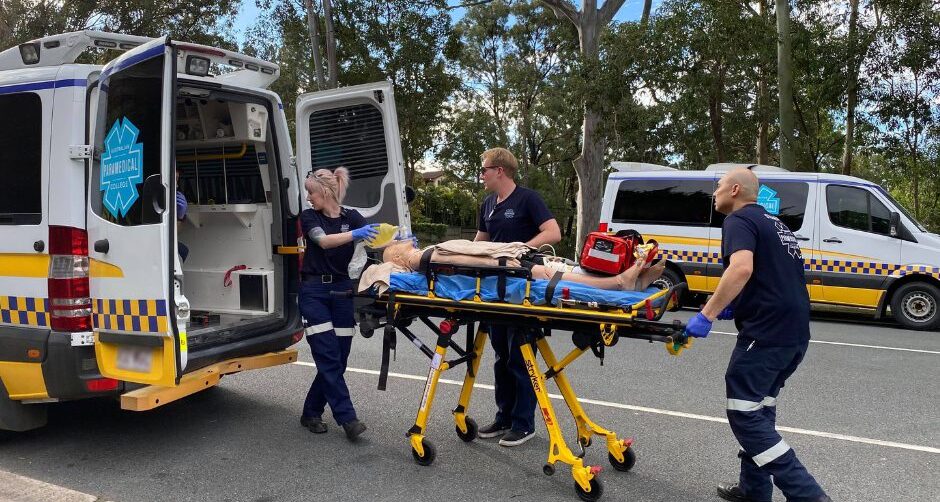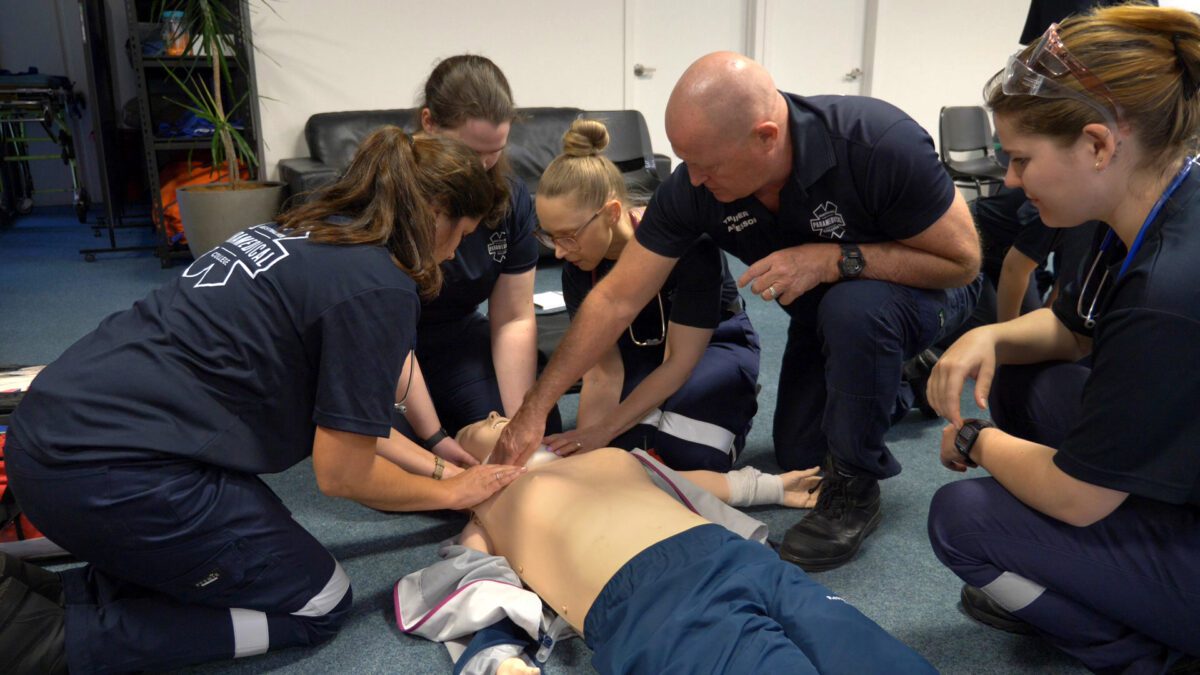Re-published 14th March, 2024
Did you know that it’s possible to become a Basic-to-Advanced Life Support Medic within the pre-hospital sector in just 12 months? We all know how fast a year can fly, but for driven and determined individuals, this short timeframe is all needed to gain the qualifications. If this sounds like something of interest to you, we’re here to tell you how.
If your goal is to work as a Registered Ambulance Paramedic or Officer, the timeframes can be a little longer, needing to complete the relevant Bachelor. You can learn more about the pathway to becoming a Paramedic via university by clicking the button below.
If your true purpose is to help people, give back to your community and make a difference, keep reading!
A step-by-step guide for beginners
If the healthcare sector is new to you but something you’re passionate about working in – don’t feel alone. According to a study* of over 2,000 individuals, approximately 30% had decided to change careers at one point in their professional lives. Whilst it can seem daunting, deciding to change careers has many positives. To begin, it offers you growth, more excitement and passion for your work, but also assists in leaving an industry that could be shrinking. According to the Australian Government’s Labour Market Insights, the Health Care and Social Assistance industry is Australia’s largest employer, with a past growth of 25.8% and an expected future growth of 15.8%. This means that you’re in a safe industry that has plenty of areas for career development too!
*Career SideKick (2024)
*Labour Marketing Insights (2024)
The difference between a Medic and a Paramedic
Working in a fast-paced environment interests you, studying to become a Basic-to-Advanced Life Support Medic could be perfect for you. This career path not only offers opportunities in a stable and expanding industry but also provides a valuable chance to explore whether transitioning to become a Registered Ambulance Paramedic is the right fit for you, all before investing significant time and resources into university studies.
Interchangeably referred to as Emergency Medical Technicians (EMTs), First Responders, Ambulance Officers or else, the role is often quite similar to a Paramedic, except with a more condensed skill set, given that you can achieve the required qualification within 12-24 months instead of the 3-6 years generally required at university.

Become a Basic-to-Advanced Life Support Medic/First Responder
If you’re looking to become a Medic, you’ll likely find yourself gravitating towards the private sector rather than the public. You could expect to provide medical support at sporting events, music festivals and concerts, competitions and more.
The Basic Life Support course for Medics
To become a basic life support medic, studying a HLT41120 – Certificate IV in Health Care could be a great place to start. It is an entry-level qualification and provides you will all the skills needed to be successful in the role.
Nationally recognised through Australian Paramedical College, you could expect to complete this course within a 12-18 month timeframe.
The Advanced Life Support course for Medics
If you want to expand your pre-hospital emergency response skills even further, a HLT51020 – Diploma of Emergency Health Care could be the essential qualification for you. Not only can you be job-ready within an 18–24-month period, but it also offers a pathway into university, offering the chance for credits and discounted course fees.
Australian Paramedical College offers this course nationally-recognised, meaning that you can take it anywhere across the nation to gain employment.
The Non-Emergency course for Patient Transport Officers
If you’re wanting to consider all options, just know that emergency isn’t the only way to work in healthcare. Australian Paramedical College offers a HLT31120 – Certificate III in Non-Emergency Patient Transport which is a great way to start a career in the sector.
Run across 12 months, it allows you to apply for positions in patient transport, transporting patients to and from medical facilities.
Paramedic qualifications in Australia
With the world rapidly changing, the pre/out-of-hospital sector is evolving with it. As such, education and higher education institutions must adjust their curriculum to prepare graduates for what lies ahead.
As of 2018, to hold and work under the title of a ‘paramedic’, one needs to have completed the relevant higher-education qualifications, namely a Bachelor of Paramedic Science/Paramedicine. With a high ATAR requirement, direct entry can be difficult, which is why we have designed our courses in line with industry standards to offer the chance of VET entry.
VET stands for ‘Vocational Education and Training’, providing graduates with on-the-job training, allowing them to excel in their careers at a fast rate. Deciding to study a VET course such as APC’s HLT51020 – Diploma of Emergency Health Care can provide you with the clinical skills to recognise, diagnose and treat a patient, but also develop your critical thinking, communication skills, emotional intelligence and leadership skills.
Emotional intelligence and communication skills are rapidly becoming an indicator of career success. As well as dealing with patients, during any given day, a Paramedic will interact with a wide array of hospital staff, doctors, nurses, assistants, clinicians, other emergency workers (firemen, police etc) and the general public. This is where your additional powers of negotiation, scene awareness, body language and the right mix of asserting yourself pay off.
We also live in a multicultural society where empathy and acceptance of other people’s beliefs and cultural values affect the outcomes of a situation you will be called to attend to.
To learn more about this pathway with APC, click here.

Why study paramedicine at Australian Paramedical College (APC)
There is no substitute for experience, especially when it comes to applying for your first paramedic/medic job. The appeal of studying pre-hospital emergency healthcare at APC is the online learning component, which accounts for over 90% of the course curriculum. This means you can continue holding full/part-time employment whilst studying, working towards these qualifications in your spare time. Just a few hours a week of study can mean you could change your life in under a year.
With the right training, a positive mindset and the necessary experience and job support you can reach your dream of becoming a State Ambulance Paramedic sooner than you ever thought possible.
Employment opportunities as a Medic or Paramedic
When you’ve graduated, knowing where to look for jobs is just as important as qualifying. One of the best tips is to understand if you wish to work in the private sector with organisations such as many of our Industry Partners, or the public sector with your jurisdictional ambulance service. Once confirmed, it’s a great idea to begin volunteering in the industry. This is the perfect opportunity to grow your network of connections, meet new people and make a name for yourself.
Stepping away from volunteering and speaking on employment, for private sector medics who may be HLT51020 – Diploma of Emergency Health Care or HLT41120 – Certificate IV in Health Care qualified, the mining sector, heavy construction and oil and gas industries are constantly looking to employ. You can often earn a good salary ($100,000+) whilst working in remote mining locations as a FIFO medic. It’s here you’ll gain valuable experience which will provide you with even more opportunities to do meaningful work down the track.
Paramedic Career Development Plan
If you’re still not sure whether a career in emergency healthcare is right for you, or you’re still a little concerned you don’t have the time, money or confidence to begin to study, then take a few minutes to tell us about yourself and your current situation and what type of job you’re looking for – we’ll show you how to get there.
A step-by-step guide and a clearly laid out plan will be created to help you understand the industry and show a way to develop a long and rewarding career helping people and saving lives. Just click the button below to start!


